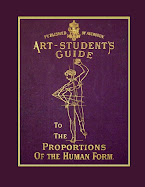William Salmon was a physician who wrote a kind of encylclopedia of the knowledge of the day. The first part of the book was dedicated to drawing and included illustrations of the human from and lessons like the one about how to square up an image in order to enlarge it.
A digital version of the book is at Google Books. Here is and excerpt describing the proportion of the human body:
CHAP. X. - Of Drawing a naked Body.
I. IN drawing after the life, as there are variety of faces, so no certain Rules can be delivered for the same, yet the following precautions may be useful.II. Draw out the head in an oval, one fourth pare for the hair, one fourth part for the forehead and brows, one fourth for the nose, and the last for the mouth and chin.
III. Having drawn out the head, measure out eight times the length of the head (the head making one of the eight parts) and draw a straight line from the top of the head to the sole of the foot.
IV. One heads length from the chin is for the breast; the next eighth part reacheth to the navel, the fourth part to the privities, the fifth part to the middle of the thigh, the sixth part to the lower part of the knee, the seventh to the finall of the leg, and the eighth part to the heel.
V. The muscles you must observe to draw exactly as they are in the life : the breadth of the shoulders, is about two measures of the head: the breadth of the hips, two measures of the face: the arms stretched out, are just the length of the whole figure, the breasts also accounted, but without the breasts they are but six.
VI. The arms hanging straight down reach within a span of the knee; the length of the hand is the just length of the face.
VII. Observe first to draw the head exactly, and next, the (shoulders in their just breadth: then draw the trunk of the Body, and the rest as at the first Section of the ninth Chapter.
VIII. Be sure to place the joynts, sinews, and muscles in their natural places, and also proportionately in respect of Magnitude, Similitude, and Parts. lest it seem crooked and deformed.
IX. See that every parallel joynt bend moderately, so as to answer in nature its opposite.
X. Lastly, It will be extreamly advantageous to draw very much after the life, and after good prints of Anatomy, and ftatues and Anatomies made of Plaster of Paris, which is the only way to arrive at the perfection of drawing a naked Figure well, and without which indeed, you can never expect to be a good Artist. The Picture also ought to be, quick, free, and lively; and if you have many of them in one piece, they ought to be so ordered as that they may not seem to be crouded, or to fall offensively, but ordering them gracefully (on the fore ground especially) so to manage the whole, that the rest of the Figures decline and lessen proportionably and by degrees, both in height or magnitude and strength, according to their feveral distances.
Another image at The Othmer Library of Chemical History.
More information at StarDotStar Books: A 17th Century Renaissance Man, Dr William Salmon: In which a 17th Century Mrs Beeton talks of religion, cookery, medicine, dentistry, herbs and ever so much more.
On the Gilding & Dying of Paper, &C. an Excerpt From William Salmon's Polygraphice (1685)
Polygraphice: Or, The Arts of Drawing, Engraving, Etching, Limning, Painting, Varnishing, Japaning, Gilding, Etc in Two Volumes Enlarged with about Five Hundred Considerable Additions Thru the Whole Work; and the Addition of Almost Five Whole Books, Not in Any of the Former Impressions: Adorned with XXV Copper Sculptures, the Like Never Yet Extant
A copy is in the University of Princeton Library.




















No comments:
Post a Comment